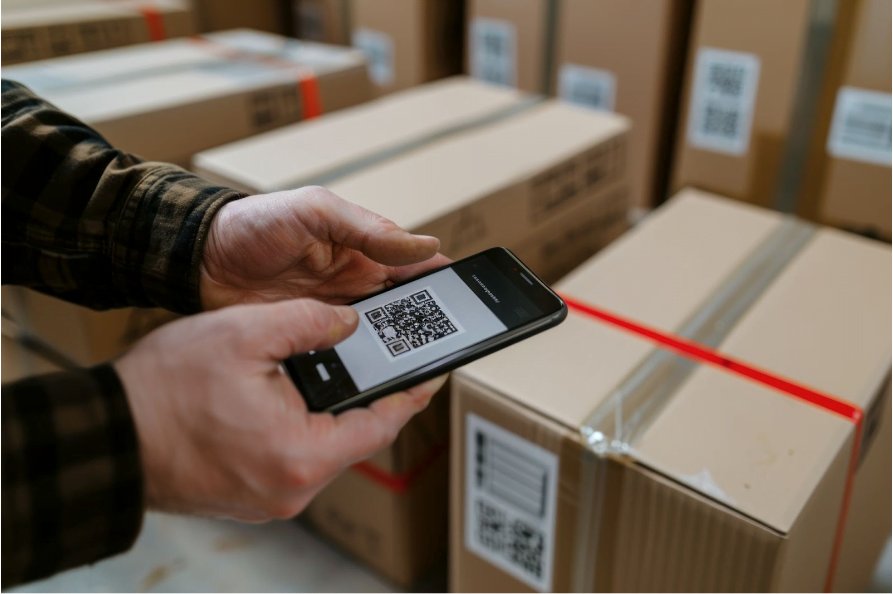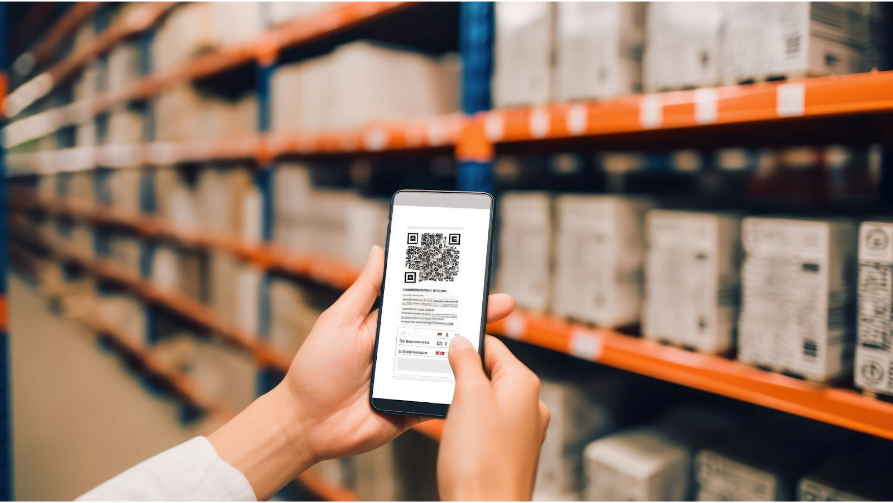When you’re investigating ways to track your assets, you’ll read a lot about QR Code and Barcode tracking options. When it comes to QR codes vs Barcodes, what are the differences? And which is right for you?
Spoiler alert: whether you use QR Codes or Barcodes, you’ll still be able to track and manage your assets, but QR Codes have some critical advantages over Barcodes in terms of their capabilities.
History and Development
Barcodes
The barcode journey began in the 1950s when two American inventors, Norman Joseph Woodland and Bernard Silver, devised the first barcode system. Inspired by Morse code, they devised a way of encoding data in a series of parallel lines of varying widths. In 1974, for the first time, a pack of Wrigley’s chewing gum was swiped with a barcode at a supermarket in Ohio, thus beginning across-the-board retail adoption.
It was only a short period before barcodes became integral to many industries due to the ease of inventory, sales monitoring, and logistics. Since it was easy to use and offered excellent service, the most common type, the Universal Product Code, became standard in retail. Later, innovations like the Code 39 and Code 128 formats increased its data storage capacity and versatility, which continued to entrench barcodes as one of the foundations of contemporary business operations.
QR Codes
QR codes, or Quick Response codes, were invented in 1994 by Denso Wave, part of the Toyota Group, for the purpose of enriching its manufacturing process. The difference between a barcode and a QR code is that it is a two-dimensional counterpart of the standard barcode that can encode much more information within tiny spaces. Initial applications included encoding information for automotive parts during the assembly process; however, it found other applications.
The wide diffusion of smartphones contributed to the popularization of QR codes since consumers were given the ability to scan them with their phones, get information, access websites, and use services with ease. This makes QR codes a versatile tool in marketing, for the tracing of products, and in delivering information. QR codes are able to store alphanumeric characters, URLs, and other kinds of data, thus being a solid solution for modern digital interactions.
From advances in security features and error correction to customization, it is in the process of evolution to this very day – the guarantee that the QR code will stay relevant in a fast-advancing digital world.
What Is A Barcode?

A barcode is a one-dimensional (1D) machine-readable code which is made up of a pattern of lines of varying widths. Commonly, barcodes are accompanied by numbers too. This means that should a barcode not be readable, the code can be manually entered instead.
Barcodes are ubiquitous. They’re the most common auto-identification technology used for stock control and to store basic information about products. Historically, a barcode scanner has usually been required to read the information in the barcode, but nowadays, even your smartphone can interpret this data. With technology evolution, business often uses barcode gps tracking for asset management.
What Are The Benefits of Using Barcodes?
Features of barcode asset tracking are famous for their simplicity and user-friendliness. Creating and implementing them is easy and they don’t need much technological infrastructure. This feature allows businesses of any size to easily access them. Furthermore, barcodes are budget-friendly, with inexpensive printing costs and easily accessible scanners. When it comes to speed and accuracy, the barcode scanner vs QR code scanner – the first outshines by allowing fast scanning and minimizing human errors related to manual input. Their ability to be used in a range of industries like retail, healthcare, logistics, and manufacturing supports various functions such as tracking inventory and processing point-of-sale transactions.
What Are The Downsides Of Barcodes?
When it comes to asset tracking, barcodes have some limitations where QR Codes do not. Firstly, due to the one-dimensional nature of the barcode, there is a limit to the amount of data it can store.
In addition, the way barcodes are used means that, in practice, they are usually not unique. Famously, barcodes are used to identify item type rather than individual items.
If you’re using a self-checkout machine, for example, and you have three packs of microwave rice to scan through, if each one is the same then you can scan one of the packet’s barcodes three times, rather than each individually.
As a result, if you are attempting to track more than one of the same asset using barcodes, you will need to make sure your barcodes have unique tags on them, rather than just using those they have already. Thus, if we look at the QR code vs barcode for inventory management – the first is usually a better choice.
What Is A QR Code?

A QR Code is a type of matrix barcode. You’ll recognise them as being, most often, a mixture of black and white squares and dots. QR codes can contain many different types of data.
The most common things held in QR codes are website URLs, email addresses, contact data and text information. There are many innovative uses for QR codes, though, including quick and easy access to your WiFi router.
What Are The Benefits Of QR Codes Over Barcodes?
Unlike barcodes, QR Codes are two-dimensional as they have rows and columns which combine to make a grid of modules. As a result, QR codes can contain much more data than a barcode of equal size. The more data the QR code contains, the ‘busier’ it will look.
QR codes also have correction abilities. This means that if your QR code is incomplete due to being covered by dirt or scratches, there is a higher chance that it can still be read, in comparison to a barcode. For anyone responsible for managing tools and equipment that spend most of their lives in the back of Engineers’ vans or left outside in yards – this will be music to your ears!
Disadvantages of QR Codes
Even with these benefits, QR codes pose specific difficulties of their own. Introducing QR code systems may require businesses to incur starting expenses for software and training, as well as potentially creating mobile apps or incorporating QR code features into current systems. The dependence on QR codes on smartphones or dedicated scanners could be a drawback because some users might not have the required technology. Problems like weak internet connection or old devices can also hinder their performance. QR code vs barcode, in comparison, even if customizable, may clash with packaging or promotional material designs at times. Ultimately, user acceptance may pose a challenge, as certain people may be unfamiliar with or reluctant to use QR codes because of security worries, requiring initiatives to inform users about their advantages and security measures.
QR Codes Vs Barcodes – A summary of the differences

- A large amount of data needed
The amount of data a QR code can hold over a barcode is arguably the most significant difference. QR codes are two-dimensional as opposed to their one-dimensional barcode counterparts. This means that QR codes can contain much more data.
- Uniquely identifying items
Barcodes on items we purchase are not unique. This means that if you have 3 of the same item, they will have the same barcode. This is a problem if you wish to use your items’ barcodes to track assets individually. Instead, QR codes can be used to give a unique identity to assets.
- Robustness and ease of scanning
We all expect the scanning of an asset’s tag to be very quick. As QR codes can be read from any direction, they are much easier and quicker to scan.
In addition, due to the error correction capabilities inherent in QR codes, they offer superior robustness against dirt and scratches. Even if your QR code is scratched, it has a higher chance of successfully being scanned. This is especially important when it comes to equipment tracking and management, as equipment will experience a lot of wear and tear throughout its life, as will the asset tags you’re using. We always recommend purchasing robust metal QR tags to ensure the longevity of your investment.
Which Is Better?
In the context of asset tracking and tagging, QR codes give you superior flexibility and tracking options.
When it comes to tracking enterprise assets, you must be able to identify your tools and equipment uniquely. Take three computer screen cables, for example. On paper and in terms of their barcodes, each cable is identical.
However, from the perspective of the business, one cable may be showing signs of splitting and should therefore be marked as needing repair and not used until safe to do so. The other two are fine and available for use. Here, it’s easy to see how critical it is to use QR codes to identify each asset uniquely.
The fact that QR codes can get damaged and still be usable is also a crucial factor in asset tracking.
If you’re weighing up between barcodes vs QR codes, we’d always recommend QR codes as being the better investment, as they offer uniqueness, can contain more data and crucially, are likely to last longer.
If you’re looking to purchase some asset tags to track your assets, check out our asset tagging options. You can also contact us at team@itemit.com or by calling 01223 421611.

Try itemit
Choose a better way to track
your assets.
Start your free 14-day trial now!
Frequently Asked Questions
What are the cost differences between implementing QR codes and barcodes for asset tracking?
Barcodes are generally cheaper to implement, with low printing and scanner costs. QR codes might incur higher initial costs due to potential software and advanced printing needs, but they offer greater data capacity and functionality, which can lead to long-term efficiency gains.
How do QR codes and barcodes compare in terms of scanning speed and accuracy in various environments?
Barcodes scan faster in controlled environments like supermarkets or warehouses, where products are clearly labeled. QR codes, although slightly slower, can be read from various angles and offer higher error correction, making them ideal for densely packed or hard-to-access items.
Are there any specific industries or use cases where barcodes might still be more advantageous than QR codes?
Barcodes are more advantageous in retail for point-of-sale transactions due to their simplicity and speed. They are also preferred in healthcare for medication and patient identification, and in manufacturing for tracking parts and products efficiently during the production process.

Keep Learning
itemit Blog
Tips, guides, industry best practices, and news.
Track Your Agricultural Assets With RFID Tags
Discover how RFID technology enhances agriculture management with better inventory tracking, livestock monitoring, and operational efficiency, even for small farms.
Which Is Better? RFID Tags Or Barcodes?
Is RFID asset tracking better than using barcodes or is it vice versa? Read this post now to discover which option is ideal for you!
The Future Of Asset Tracking Involves RFID Tags: Here’s Why
Find out exactly why the future of asset tracking in the workplace involves RFID asset tracking by reading this article now!


